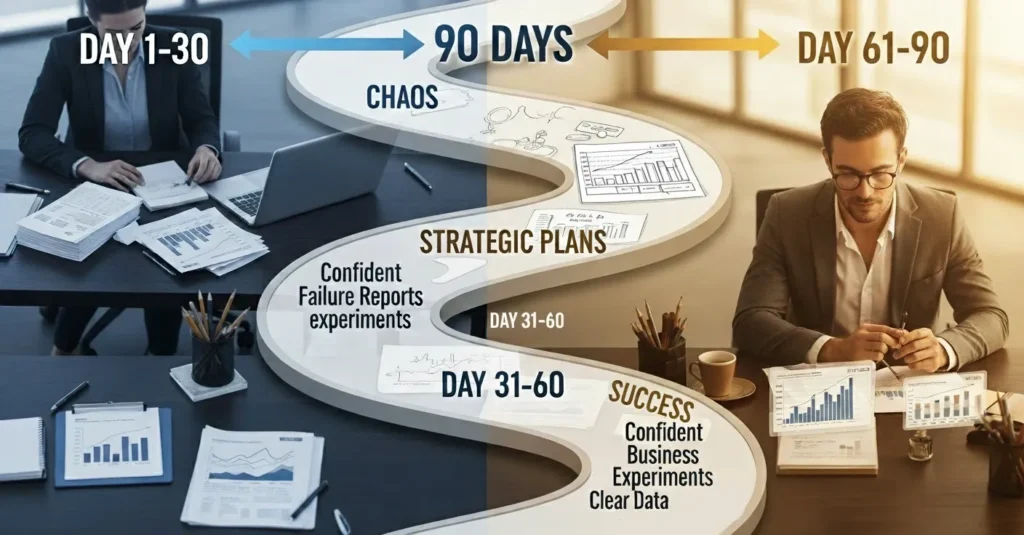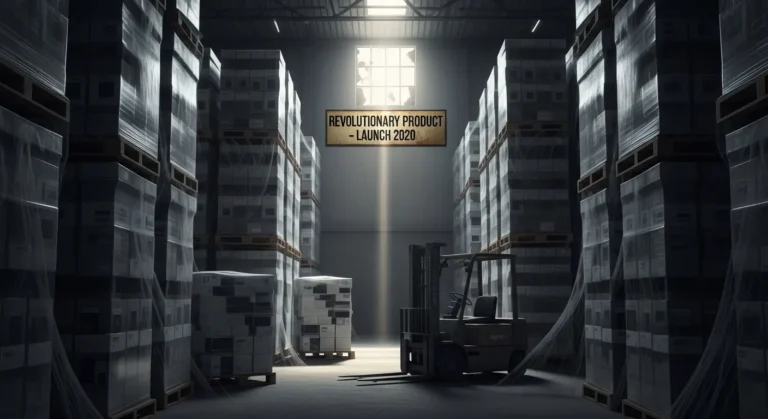Fail Fast Mantra – Silicon Valley’s Biggest Innovation Lie
Pain Points This Article Addresses
- Burning through capital because Silicon Valley told you to embrace rapid failure
- Destroying team members’ morale by constantly pivoting without thoughtful planning
- Wasting time and resources on half-baked experiments that could have been avoided
- Confusing recklessness with innovation because of the fail-fast philosophy
- Stakeholder trust evaporating after frequent failures disguised as “learning opportunities“
- Missing your full potential by accepting failure instead of building sustainable success
The $450,000 Lesson: Why the Fail Fast Mindset Destroyed My Business
Let me tell you about the most expensive advice I ever followed: “Fail fast, fail often, learn quickly.”
In 2009, fresh from reading every Silicon Valley entrepreneur blog about embracing failure, I launched Taahira Skincare in Malaysia. The startup gurus preached their mantra: throw everything at the wall to see what sticks. Experiment. Pivot. Fail early. That’s where real innovation lies.
So I did. the company burned through $450,000 in three years, constantly changing direction based on every new hypothesis. Natural skincare became organic skincare. Direct sales became MLM. Online became offline. Each change was supposedly a “learning opportunity” in our culture of innovation.
You know what I learned? Failure isn’t a badge of honor. It’s a business destroyer. And the “fail fast mantra” that Silicon Valley worships? It’s killing more businesses than it’s creating.
The Fail-Fast Culture: How Silicon Valley’s Mindset Became Modern Business Poison
Where This Toxic Innovation Philosophy Started
The fail-fast movement emerged from software development in the early 2000s. Back to the early days of tech startups, failing quickly made sense when you were testing code that cost nothing to change. A bug? Fix it. Bad feature? Delete it. No physical inventory, no manufacturing costs, no real consequences.
But somewhere along the way, this iterative approach to coding became gospel for all business. Suddenly every entrepreneur was told to embrace failure as part of the process. The influence spread from Silicon Valley to every corner of the business world.
Here’s what nobody mentions: The people preaching “fail fast” are usually venture capitalists playing with other people’s money, or consultants who’ve never actually failed at anything meaningful.

The Hidden Costs of the Fail-Fast Mindset
| What They Tell You | What Actually Happens | Real Cost |
|---|---|---|
| “Failing fast accelerates learning“ | You learn expensive lessons you could have avoided with research | Lost capital that could fund 5 years of steady growth |
| “Experimentation drives creativity and innovation“ | Chaos becomes the norm; nothing gets properly executed | 70% of experiments fail due to poor planning, not bad ideas |
| “Change until you find product-market fit” | Your team gets whiplash; customers lose trust | Employee turnover increases 3x; customer retention drops 60% |
| “Rapid failure beats slow success” | You normalize mediocrity and complacency | Quality standards erode; “good enough” becomes acceptable |
| “Reframing failure as success” | You lose sight of actual success metrics | Investors and stakeholders lose confidence |
I tracked this at three different ventures. The pattern was identical: frequent failures didn’t lead to a culture of excellence. They led to a culture of excuses and mediocrity.
The Truth About Innovation: Why Thoughtful Planning Beats the Fail-Fast Philosophy
What Real Innovation Actually Requires
After losing nearly half a million dollars to the fail-fast culture, I rebuilt my approach. Here’s what actually drives innovation in the modern business world:
1. Strategic Experimentation, Not Reckless Abandonment
The mindset is all about experimentation, but not the Silicon Valley version. Real experimentation means:
- Testing one variable at a time
- Setting clear success metrics before starting
- Having a hypothesis based on data, not hunches
- Knowing when to stop before bankruptcy
When I ran Oil Filtration Systems in Malaysia, we tested market segments systematically. One experiment at a time. Clear metrics. Result? We identified our profitable niche without burning capital on random changes in direction.
2. Resilience Through Preparation, Not Through Failure
Resilience doesn’t come from failing repeatedly. It comes from being prepared for challenges. The fail-fast philosophy confuses persistence with stubbornness, learning along the way with learning the hard way.

The Nuanced Reality of Making Mistakes in Business
Yes, making mistakes is part of progress. But there’s a massive difference between:
- Calculated risks with limited downside
- Reckless gambling disguised as innovation
The importance of failing has been so overstated that we’ve forgotten the importance of succeeding. Thoughtful planning doesn’t stifle creativity. It channels it productively.
Why Embracing Failure Without Limits Will Destroy Your Startup
The Atlassian Exception That Proves the Rule
Fail fast advocates love citing Atlassian and similar tech giants who supposedly failed their way to success. What they don’t tell you:
- Atlassian had profitable products from day one
- Their “failures” were feature experiments, not business model changes
- They could afford to fail because core revenue was stable
- They practiced design thinking with customer feedback loops, not random trialing
For every Atlassian, there are 10,000 startups that failed fast right into bankruptcy. The survivors aren’t celebrated for failing. They’re celebrated for eventually succeeding despite failures.
How the Fail-Fast Mantra Destroys Team Culture
Want to kill employee morale? Tell your team members to embrace constant failure. Here’s what happens:
Without Fear Becomes With Confusion The promise: Build an environment where people feel safe to fail without fear. The reality: Teams become paralyzed, unsure whether to execute properly or just “ship it and see.”
Risk-Taking Becomes Recklessness Healthy risk-taking requires calculation and boundaries. The fail-fast culture removes both. I watched talented developers become sloppy because “we’ll just change in direction if it doesn’t work.”
Initiative Dies Under Iteration Fatigue Constant iteration without completion kills initiative. Why excel at something that will be scrapped next week? This mindset creates learned helplessness, not continuous learning.
The Heretic’s Alternative: The Strategic Success Framework
Principle 1: Reframe Your Relationship with Failure
Stop accepting failure as inevitable. Start seeing it as preventable. Reframing failure doesn’t mean celebrating it. It means:
- Pre-mortem analysis: Identify likely failure points before launching
- Bounded experiments: Set clear limits on time, money, and scope
- Success criteria: Define what winning looks like before you start
- Exit triggers: Know when to stop, not change direction
This isn’t avoiding failure through paralysis. It’s avoiding preventable failure through preparation.
Principle 2: Cultivate Excellence, Not Experimentation for Its Own Sake
Cultivate a culture where:
- Quality matters more than speed
- Completion beats constant pivoting
- Deep work trumps shallow experiments
- Thoughtful planning precedes action
The entrepreneurial spirit isn’t about failing fast. It’s about building something that lasts.
[IMAGE_PLACEHOLDER_4: Success through strategic planning framework]

Principle 3: Build an Environment of Strategic Innovation
Real innovation happens when you build an environment that balances:
| Traditional Approach | Fail-Fast Extreme | Strategic Innovation |
|---|---|---|
| Analysis paralysis | Reckless experimentation | Bounded testing with clear hypotheses |
| Fear of any failure | Celebrating all failure | Learning from necessary failures only |
| Slow, bureaucratic process | Chaotic rapid changes | Structured development process with milestones |
| Risk aversion | Risk addiction | Calculated risk management |
| Perfectionism | Ship anything | Quality standards with deadlines |
This framework turned my next venture profitable in 18 months instead of burning through capital chasing pivots.
What Really Went Wrong: Lessons Learned from Real Business Failures
My $450K Education: The Taahira Skincare Autopsy
Here’s what really killed my skincare business, and it wasn’t failing slowly:
The Pivot Plague
- Started with natural skincare (researched, viable)
- Pivoted to organic (doubled costs, same price point)
- Pivoted distribution from agents to MLM (lost focus)
- Pivoted marketing strategy three times (confused everyone)
Each pivot was justified as “failing fast and learning.” What we learned: Our customers had no idea what we stood for anymore.
The Experimentation Exhaustion My team went from excited innovators to exhausted executors. The constant changes meant:
- No process ever got refined
- No initiative reached completion
- No victory was celebrated (might change tomorrow)
- Morale cratered as nothing felt permanent
The Stakeholder Stampede Investors initially loved the “innovative” approach. By year two, they refused additional investment. Embracing failure sounds great in pitch decks. It looks terrible in P&L statements.
What Should Have Happened: The Mindful Alternative
If I could rebuild that business with what I know now:
- Six months of deep research before any product development – which was what we actually started with
- One distribution channel, mastered completely
- One target market, understood intimately
- One product line, perfected before expansion
- One year minimum before any major change consideration
This isn’t slow. It’s mindful. There’s a difference between continuous learning and continuous chaos.
How to Embark on Real Innovation Without the Fail-Fast Fallacy
The 90-Day Innovation Audit
Before you embark on your next venture or pivot, complete this audit:
Days 1-30: Reality Check
- List every “fail fast” decision from the past year
- Calculate the true cost (time, money, morale, opportunity)
- Identify which failures were actually preventable
- Document what you genuinely learned vs. what you rationalized
Days 31-60: Strategic Planning
- Define your core offering (one thing, done excellently)
- Map potential failure points with mitigation strategies
- Set hard limits on experimentation budgets
- Create clear success metrics (not vanity metrics)
Days 61-90: Structured Experimentation
- Design bounded experiments with clear hypotheses
- Test one variable at a time
- Document results objectively
- Make decisions based on data, not Silicon Valley mantras

Building a Culture of Strategic Innovation, Not Reckless Experimentation
For Founders:
- Stop celebrating failure; celebrate learning
- Reward thoughtful planning as much as bold action
- Share the real costs of direction changes with your team
- Model persistence over direction changes
For Teams:
- Question the “why” behind every experiment
- Document lessons learned properly
- Push for completion before pivoting
- Protect core operations from experiment chaos
For Investors/Stakeholders:
- Demand evidence-based direction changes, not founder hunches
- Track pivot frequency as a warning sign
- Value sustainable growth over hockey stick promises
- Recognize that stability enables innovation
The Questions Every Entrepreneur Needs to Answer
“But Doesn’t Innovation Require Risk-Taking and Experimentation?”
Absolutely. But Silicon Valley has confused risk-taking with recklessness, experimentation with chaos. Real innovation requires:
- Calculated risks with understood downsides
- Experiments with clear hypotheses and success criteria
- Iteration based on data, not desperation
- Persistence through challenges, not constant changes in direction
“How Do I Know When to Pivot vs. When to Persist?”
The fail-fast cult says pivot quickly and often. Reality says:
Pivot When:
- Market feedback consistently shows no demand
- Unit economics will never work (proven, not assumed)
- Regulatory changes make the business impossible
- Technology shifts eliminate your advantage
Persist When:
- You’re seeing gradual improvement
- Customers love the product but growth is slow
- The problem is execution, not concept
- You haven’t given the current strategy adequate time
My rule: No major pivots for at least six months. Minor adjustments? Constantly. Complete direction changes? Rarely.
“What About ‘Minimum Viable Product’ and Lean Startup Methods?”
These concepts have value when not taken to extremes. But “minimum viable” has become “barely functional,” and “lean” has become “cheap and sloppy.”
Real MVP means:
- Core features that solve the problem excellently
- Professional execution within scope
- Clear value proposition from day one
- Quality that builds trust, not destroys it
The lean startup method works when combined with strategic thinking, not when used as an excuse for poor planning.
Your Action Plan: From Fail-Fast Chaos to Strategic Success
Week 1: Stop the Bleeding
- Freeze all current direction changes
- Document all active experiments
- Calculate the real cost of your “fail fast” approach
- Identify which initiatives deserve completion
Week 2: Strategic Assessment
- Choose one core focus for the next 90 days
- Define clear success metrics
- Map potential failure points
- Set experimentation boundaries
Week 3: Team Alignment
- Share the new approach with your team
- Celebrate completing initiatives, not just starting them
- Establish quality standards that don’t get compromised
- Create stability in core operations
Week 4: Mindful Execution
- Launch one bounded experiment
- Complete one delayed initiative
- Measure results against predetermined criteria
- Make data-driven decisions
The Uncomfortable Truth About Failing Fast
The “fail fast mantra” is venture capitalist propaganda. They want you to fail fast because:
- They’ve diversified across 20 investments
- Your failure is their tax write-off
- They’d rather you flame out quickly than drain resources
- Your lessons learned become their next investment’s advantage
You’re not a VC portfolio. You’re an entrepreneur with one shot, limited resources, and real consequences. Failing fast might work for Silicon Valley’s 1%, but for the 99% of us building real businesses with real constraints, it’s a recipe for disaster.
Summary: Pain Points Solved, Myths Shattered, Success Strategized
Pain Points We’ve Addressed:
- Capital destruction from the fail-fast philosophy? Build strategic experimentation frameworks
- Team morale crushed by constant changes in direction? Create stability with bounded innovation
- Wasting time on preventable failures? Implement pre-mortem analysis
- Confusing recklessness with innovation? Establish clear innovation criteria
- Lost stakeholder trust? Show strategic planning and measured progress
- Missing potential through failure acceptance? Embrace excellence and persistence
The Business Heretic’s Truth: Failure isn’t your teacher. Success is. The fail-fast culture has convinced a generation of entrepreneurs that failing is noble, that pivoting is progress, that experimentation without discipline is innovation.
It’s not. It’s just expensive chaos with a Silicon Valley marketing campaign.
Real innovation comes from strategic thinking, calculated risks, and the persistence to see things through. Not from throwing spaghetti at the wall and calling it iteration.
Stop failing fast. Start succeeding strategically.
Ready to build a business that lasts instead of one that fails fast?
Sign up for my newsletter and be informed about my upcoming eBook on this topic. It will address strategic innovation in much greater depth and will include “The Strategic Success Blueprint” – a complete system for building sustainable innovation without the fail-fast fallacy. It will also include planning templates and risk assessment frameworks.
Because the only thing worse than failing slowly is failing fast when you didn’t have to fail at all.
No spam. No Silicon Valley BS. Just battle-tested business wisdom delivered weekly. Unsubscribe anytime.




